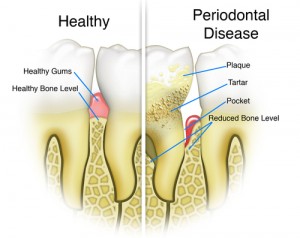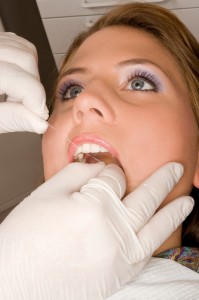It is estimated that more than half of all adults age 35 and older have early to advanced stages of periodontal disease. Periodontal disease (PD) is the primary cause of lost teeth after the age of 35 – not dental cavities!

What is periodontal disease ?
Periodontal disease is a chronic gum infection caused by plaque resulting in loss of bone support around the roots of teeth. Plaque is a thin film of bacteria that forms on teeth. Plaque converts to tartar if not cleared form teeth after 24hrs. Tartar irritates gums leaving them red, swollen and bleeding readily.
Eventually the gums peel away form teeth and create small pockets between the teeth and gums, slowly continuing to also destroy the supporting bone. Severe loss of the supporting bone is what loosens up teeth and make them incapable of functioning properly. Periodontal disease is often painless and will go undetected until bone loss is so severe that teeth are so loose they need to be extracted.
What are the signs ?
Early Stages:
• Bleeding gums when you brush or floss
• Red, swollen, tender gums
• Gums that have receded or shrunken away from teeth
Later Stages:
• Loose teeth, or teeth that have moved, or more spacing between teeth (especially front teeth) resulting in changes in bite or in the fit of dentures
• Foul smell or taste and/or pus that can be expelled when pressing on the gums
What can you do ?
The best way to treat periodontal disease is by early detection and prevention. A thorough examination can tell if you are at risk. Once diagnosed with periodontal disease, one must try to prevent further loss of supporting bone and/or other teeth.
Treatment usually involves a thorough scaling and root planing to remove plaque and built up tartar, thus allowing healthy gums tissues to reattach to root surfaces of teeth. Clean surfaces of teeth must be maintained by meticulous home oral hygiene and routine check-ups and cleaning.
Remember: There is really no cure for this “silent tooth killer”; cleanings can only dramatically slow down the disease process. Only early detection and prevention can make the difference between premature loss of teeth and a full compliment of healthy strong teeth.
Source: http://www.drchoo.com/images/preventive04.gif
 Gum disease, also known as periodontal disease is a chronic intra-oral bacterial infection that does have systemic health implications.
Gum disease, also known as periodontal disease is a chronic intra-oral bacterial infection that does have systemic health implications.


















